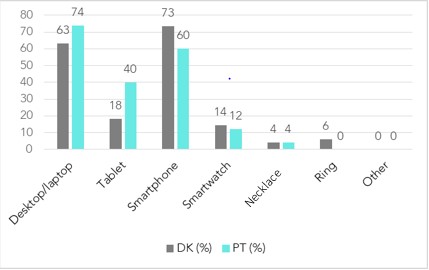
31 Jul FEATURE BLOG POST: User requirements for SmartWork system – findings from consultation with office workers
July 2019: Willeke van Staalduinen, Sofia Ortet and Carina Dantas (Cáritas Diocesana de Coimbra) share findings from the first phase of consultation with office workers
To learn more about the needs and demands of Danish and Portuguese office workers aged 55+, an online questionnaire was created. 50 Portuguese and 49 Danish office workers responded. In both samples 70% females and 30% males participated. The majority of them intends to retire at legal retirement age.
Regarding the health of the workers 12% report to have hearing problems and 6% use a hearing aid. 27% of the Danish and 70% of the Portuguese respondents have an eye vision problem. 49% wears glasses. Half of the workers report to have a chronic disease or condition. Most frequent reported diseases are: hypertension, limb using problems, rheumatism, arthritis and diabetes. 93% of them report not to have any difficulties at work due to the chronic disease or condition. 12% of the Danish and 26% of the Portuguese respondents were on sick leave in the last 3 years, mainly less than 5 weeks.
Working at a desk and at a computer (desktop or laptop) are the main activities during the day at the office. Danish employees use laptops and smartphones; Portuguese employees use more desktops and smartphones. Danish workers are almost for 100% familiar with ICT; Portuguese only 64%. Portuguese and Danish office workers of 55+ most value a SmartWork application that will inform them on meetings and events and provides guidance or training in performing computer tasks. Applications that check the health status every minute, every day or every week, report on the working time at the computer or inform the boss on the performances are not found (very) useful by the respondents. The most preferred interaction with the system should be by keyboard or touch screen. Preferably the SmartWork system should become available on desktop/laptop or on smartphone (Figure 1).

These findings were used to define four personas in order to be able to identify the user requirements regarding the SmartWork system. These requirements are the base for the definition of the technical requirements of the worker-centric AI SmartWork system.
To read more: A full report on the co-design methodology, user requirements and use cases has been published in D2.2, available here.
Make sure to follow us on Twitter, LinkedIn and Facebook for project updates and sign up to the Newsletter.
Questions? Contact smartwork@echalliance.com



